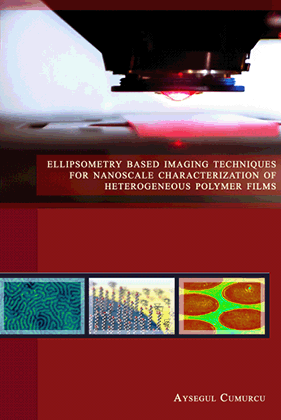
In this thesis, hybrid methods for nanoscale characterization of heterogeneous thin polymer films were discussed. Essentially two ellipsometry based hybrid meth¬ods were established or further developed, respectively, namely electrochemical imaging ellipsometry (EC-IE) and scanning near field ellipsometry microscopy (SNEM). Ellipsometry was combined with electrochemical methods for the vi¬sualization of redox driven dynamic changes in thin polymer films. In particu¬lar, the redox responsive behaviour of an oligoethylene sulfide end-functionalized poly(ferrocenyldimethylsilane) (ES-PFS) film was investigated with this hybrid method against a passive (non-redoxactive) 11-mercapto-1-undecanol (MCU) layer. The thickness change of the PFS layer upon oxidation and the reduction was ob¬served in situ in real time with EC-IE.
This hybrid method provides vertical resolution at the sub nanometer scale while its lateral resolution is limited to the wavelength of the light source (λ = 633 nm). In contrast, SNEM reveals lateral resolution below the diffraction limit of the light. The emphasis of the thesis was devoted to SNEM, including the introduction of the instrument, experimental case studies to enlighten its contrast formation and the optimization of the method. SNEM enables optical contrast imaging of thin transparent polymer films at the nanoscale due to the combination of the spatial tip-sample positioning capability of the atomic force microscopy (AFM) together with the high sensitivity of ellipsometry.
The motivation and the introduction of the topics that are covered in this thesis were presented in Chapter 1. The need for hybrid methods for the characteri¬zation of the nanoscale structures and the role of the hybrid methods used in this thesis were also provided in this chapter. To deliver background information on the hybrid techniques used in this thesis, Chapter 2 was dedicated not only to the summary of recent developments but also to the fundamentals of the imag¬ing ellipsometry (IE) and various scanning near-field optical microscopy (SNOM) techniques. Firstly, the basics of the far-field and near-field microscopy as well as the diffraction limit of light were explained, but the emphasis was put on the IE and its applications in polymer characterization. Lastly, the apertureless and apertured SNOM techniques were described focusing mainly on tip enhanced techniques such as tip-enhanced Raman scattering (TERS) and SNEM.
In Chapter 3, the first hybrid setup used in this thesis, the EC-IE, was in¬troduced. This method combines IE with electrochemical methods for real time imaging of electrochemical responds of thin films. In this chapter, a study on mon¬itoring in-situ thickness changes of ES-PFS relative to a molecular reference layer, the MCU layer, was provided. The ES-PFS/MCU micro-patterned sample was fabricated using micro-contact printing (µCP). Ellipsometric contrast images of the micro-patterned ES-PFS layer/MCU film were recorded in situ with a closed electrochemical liquid cell.

Additional information for Chapter 3
Subject: Video recording of the micro-patterned ES-PFS/MCU film
Description: The real time ellipsometric microscopy images of micro-patterned ES-PFS/MCU film were recorded with EC-IE, continuously while cycling the potential between -0.1 V and 0.6 V in a video recording. This recording shows the reversibility of the thickness change simultaneously with the potential change. Additionally, the movie provides evidence for the 2 step oxidation, as can be seen from a corresponding stepwise intensity increase and decrease upon reduction, respectively.
This information is provided as supplementary to thesis entitled “Ellipsometry based imaging techniques for nanoscale characterization of heterogeneous polymer films” by Aysegul Cumurcu.
.
Chapter 4, the second hybrid method, the SNEM, was explained including its experimental arrangement, the optical contrast mechanism and the field en¬hancement. Also, the contrast formation based on a model, termed point dipole model, which describes the interactions between the tip and the sample for aper¬tureless SNOM techniques was explained. The model calculations were compared to the experimental results in this thesis. Lastly this chapter covered the back¬ground scattering which originates from the multiple reflections between the large illuminated areas of the cantilever and the sample surface.
in Chapter 5 SNEM images of a microphase separated nanoscale morphology of a poly(styrene¬b-2-vinyl pyridine) (PS-b-P2VP) diblock copolymer film was studied to better understand the SNEM optical contrast mechanism. For instance, the importance of using a gold coated probe tip for the field enhancement was shown by comparing SNEM images obtained with a gold coated and a bare silicon probe tip. The dielectric constant variation driven nature of the SNEM optical contrast images was shown by comparing the SNEM images of a PS-b-P2VP copolymer film which were captured before and after iodine staining. By staining this block copolymer with iodine, the P2VP domain reacts with iodine resulting in a domain with higher dielectric constant. The PS domain, however, did not change its configuration and therefore, also the dielectric constant upon iodine staining. Lastly, the effect of the tip sample distance to the optical contrast was investigated by recording SNEM optical images at various tip sample distances. The experimental results in this chapter were compared to the point dipole model calculations.
The lifetime of the gold coated probe tips, used in SNEM measurements, was investigated in Chapter 6. The gold coated AFM probe tips lose their activity over time when stored in ambient air. Therefore, SNEM optical data obtained with a freshly prepared metal coated probe and an aged probe are not directly comparable. To prolong the lifetime of the metal coated probes, a self-assembled monolayer (SAM) of ethanethiol (EtSH) was used as a protective coating. Per¬formance of the gold coated and the SAM protected gold coated probe tips were measured by comparing the amplitude of the intensity variations of the SNEM images collected with these probe tips. A microphase separated polystyrene¬block-poly(methylmethacrylate) (PS-b-PMMA) diblock copolymer film was used as a sample in this chapter. On one hand, the SNEM images of the PS-b-PMMA diblock copolymer film, which were recorded with a gold coated AFM probe tip, showed 66% decrease in the amplitude of the intensity variations after storing the AFM probe tip five days in ambient air. On the other hand, the optical images, which were recorded with a SAM of EtSH protected AFM probe tip, showed only 14% decrease in the amplitude of the intensity variations over the same time and storage conditions. Additionally, alkanethiols of various lengths were used to modify gold coated AFM probe tips to determine the thiol length that diminished the intensity variations in the optical image. By increasing the length of the alka¬nethiol of the protective layer, the amplitudes of the intensity variations of the SNEM images captured with the respective modified AFM probe tip decreased.
In Chapter 7, the role of the effects of the SAM of 1-dodecanethiol (DoSH) coating on SNEM contrast was further investigated. Modifying the gold coated probe tip with a long chain thiol SAM of DoSH blocked the optical contrast due to the dielectric shielding of the gold coated probe tip via the densely packed SAM. The SAM molecules at the tip apex were then removed by scanning at increasing pressures. The amplitude of the intensity variations was increased in the SNEM images revealing the block copolymer domain nanostructures by removing the SAM layer. The decrease of the background scattering was seen by the intensity-distance curves. Additionally, the outlook with a discussion of the possibilities of both methods for future reseach was provided in Chapter 8.